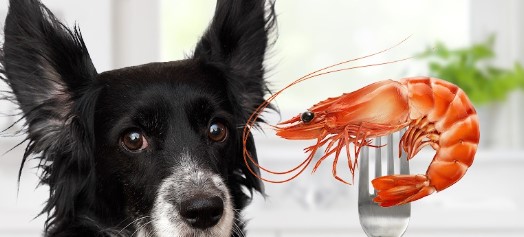Shrimp meat is perfectly safe for dogs to eat in moderation, but shrimp tails and shells can present choking hazards. Shrimp shells and tails are made of chitin, an indigestible fiber.
However, the shrimp tail is not toxic, but these fibrous materials can potentially irritate the digestive tract. Also, it can cause dangerous blockages or choking if your dog swallows in large pieces.
Some claim that shrimp shells could splinter into sharp fragments in a dog’s mouth as well. While the risks may be minimal for some dogs, it’s better to be safe than sorry.
Are Shrimp Tails Safe for Dogs to Eat?
Shrimp tails are not safe for most dogs to eat. However, Shrimp meat is safe and nutritious for dogs, so shrimp tails are likely delicate as well. Shrimp is high in protein, vitamins, and minerals.
Shrimp shells and tails are made up of chitin, which is an indigestible fiber for dogs. Thus, eating shrimp tails passes extra fiber through the digestive tract.

Some claim shrimp tails could potentially splinter and cause damage in a dog’s mouth or internally. However, there is little evidence that this is a major risk or has caused harm.
Like any new food, only feed a small amount at first to see if your dog has any digestive upset or allergic reaction. But most dogs tolerate shrimp tails well.
Potential Risks of Feeding Shrimp Tails to Dogs
There are some potential downsides to consider when feeding shrimp tails to dogs:
- Choking hazard – Large, hard chunks could present a choking risk for some dogs. That is especially true for small dog breeds. Monitor your dog when feeding tails.
- Digestive upset – Too much chitin fiber from shells could potentially cause loose stools if given in excess. Introduce slowly.
- Allergies – Some dogs may be allergic or sensitive to shellfish. Monitor for any reactions.
- Tooth damage – Aggressive chewers who break off and swallow sharp bits could potentially damage teeth or mouth/gut lining. But this seems rare.
- Nutritional imbalance – Overfeeding any treat could take away your dog’s appetite for balanced meals. Shrimp tails should only be a small snack.
Potential Benefits of Feeding Dogs Shrimp Tails
Here are some potential advantages:
- Nutritious protein source – Shrimp meat is healthy for dogs, so tails provide extra protein. That supports lean muscle mass.
- Omega fatty acids – Shrimp contain omega-3s that contribute to a glossy coat and healthy skin. Tails provide a bit more of these beneficial fats.
- Extra fiber – The fibrous chitin in shells adds insoluble fiber to promote digestive regularity.
- Chew satisfaction – Dogs like to chew. Hard shrimp tails provide a satisfying chew, similar to raw bones. That helps clean teeth, too.
- Treat boredom – Chewing tails keep dogs mentally stimulated and alleviates boredom between meals.
Are Shrimp a Healthy Treat for Dogs?
Shrimp can be a nutritious treat for dogs in reasonable quantities. The shrimp meat provides protein, omega-3s, and minerals that support good health and nutrition. And the indigestible chitin contributes some extra insoluble fiber to aid digestion.
For dogs that love to chew, shrimp provide a satisfying outlet for this natural behavior. The abrasive chewing also helps scrape away plaque and tartar to improve dental health.
Just be sure to introduce shrimp slowly and feed only as an occasional treat. Monitor your dog for any digestive or allergic reaction. Consider your dog’s size and chewing habits, as shrimp tails present a greater choking risk and tooth damage potential for aggressive chewers.
But for most dogs, the potential benefits of shrimp outweigh the minimal risks when appropriately fed. Shrimp can add some nutritional variety to your dog’s diet and provide hours of chewing satisfaction.
How to Feed Shrimp Tails to Dogs Safely
If you want to feed shrimp tails to your dog, here are some tips for doing so safely:
- Introduce slowly and only feed 1-2 tails at first to check for any digestive upset.
- Consider your dog’s size. Break large tails into smaller pieces for small or medium dogs. Leave whole for large breed dogs.
- Monitor your dog when eating to ensure they are chewing thoroughly and not attempting to swallow large chunks whole.
- Select shells from fully cooked shrimp. Raw shellfish may contain bacteria.
- Remove the vein/ intestinal tract that runs along the tail shell. This part is typically removed before human consumption, but double-check.
- Only feed tails occasionally, no more than a couple of times per week. Too many can lead to loose stools.
- Make sure your dog is still eating their regular balanced diet and not filling up on treats.
- Avoid giving tails to puppies or dogs with dental issues. Thoroughly chewing and ingesting tails is essential.
Supervise your dog at first to ensure shrimp tails agree with them. But most dogs can enjoy an occasional shrimp tail as a delicious chew treat.
Allergic Reactions to Shrimp and Precautions
Some dogs may develop an allergic reaction to shrimp. Signs can include itchy skin, ear infections, wheezing, vomiting, diarrhea, and more severe reactions like swelling or difficulty breathing.
If any severe allergic reaction occurs after eating shrimp, seek veterinary care immediately.
To be cautious, consult your vet before introducing shrimp to identify any pre-existing allergies your dog may have.
Initially, feed just a small amount of shrimp and watch for any signs of reaction over the following 24 hours, like itching, digestive upset, or skin irritation.

Discontinue feeding shrimp entirely if any adverse reaction occurs. Avoid all shellfish for dogs with confirmed shellfish allergies.
However, shrimp allergies are not common in dogs, but take precautions by introducing them slowly and watching for reactions. Consult a veterinarian if shrimp causes an allergic response to develop a hypoallergenic diet plan.
What happens if my dog eats shrimp tails?
Eating a large amount of shrimp tails may cause temporary loose stools or diarrhea from the excess fiber. Constipation is also possible if the rough fiber causes dehydration or obstruction.
More seriously, dogs that swallow large chunks of shell whole without chewing run the risk of an intestinal blockage. This requires quick veterinary care. Choking is also possible if attempting to swallow big pieces.
Other potential issues include tooth damage from breaking off sharp shell fragments or allergic reactions in dogs with shellfish sensitivities. Signs of an allergy may include vomiting, diarrhea, or itchy skin.
FAQs on Can Dogs Eat Shrimp Tails
Are shrimp tails digestible for dogs?
No, shrimp tails are made of indigestible chitin fiber. Similar to eating corn kernels, shells pass through a dog’s digestive tract intact. Only the meaty part of the shrimp provides digestible protein and nutrients.
Do dogs gain nutritional value from eating shrimp tails?
Dogs will gain some nutritional benefits from the shrimp meat still attached to the tails. It provides protein, healthy fats, and minerals. The tails themselves primarily add insoluble fiber.
Can shrimp tails splinter and hurt my dog?
Shrimp tails are quite hard, and a dog’s teeth should not be able to break them in a way that produces sharp splinters during chewing.
How many shrimp tails can dogs eat safely?
For small dogs, 1-2 tails a couple of times a week is plenty. Medium dogs can have 2-3 tails at a time, a few times weekly. Large breed dogs can handle more, perhaps 5 or so medium-sized tails as an occasional treat. But moderation is still best long-term.
Final Words
Shrimp can be a healthy treat for dogs, the fibrous tails and shells can present some risks. The shell material contains chitin, which is indigestible fiber for canines.
Consuming too much of these shells could potentially cause gastrointestinal irritation, blockages, or even choking in some cases. The sharp fragments also pose a minor risk of tooth damage or lacerations internally.
While most dogs tolerate shrimp tails without issue, it’s ideal to remove the shells before feeding for safety. Check with your veterinarian before introducing new foods as well. Some dogs may have allergies to shellfish.
